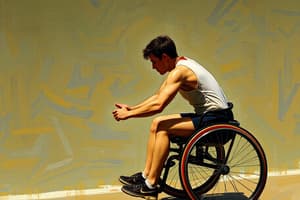Podcast
Questions and Answers
What is a vital consideration when coaching children with disabilities in sports?
What is a vital consideration when coaching children with disabilities in sports?
- Omitting any participation exams
- Avoiding communication with parents about the child's needs
- Ensuring the coach is aware of the child's disability (correct)
- Encouraging children to play contact sports
Which of the following is a recommended activity for children with disabilities?
Which of the following is a recommended activity for children with disabilities?
- Extreme adventure sports
- Swimming (correct)
- High-intensity collision sports
- Rugby
What adaptation can be made for children with visual impairments in a sports setting?
What adaptation can be made for children with visual impairments in a sports setting?
- Ensuring proper lighting and clear areas (correct)
- Brightly colored obstacles to avoid
- Using high-pitched sounds to guide the players
- Increasing the size of the playing area for better visibility
Which condition should be ruled out for children with Down syndrome before engaging in collision sports?
Which condition should be ruled out for children with Down syndrome before engaging in collision sports?
How can sports be adapted for children with mobility limitations?
How can sports be adapted for children with mobility limitations?
What is a primary goal of using personal equipment in adaptive sports?
What is a primary goal of using personal equipment in adaptive sports?
Which principle of universal design promotes ease of use for individuals regardless of their physical abilities?
Which principle of universal design promotes ease of use for individuals regardless of their physical abilities?
What distinguishes congenital conditions from acquired conditions?
What distinguishes congenital conditions from acquired conditions?
What is a characteristic of Down syndrome that may affect participation in sports?
What is a characteristic of Down syndrome that may affect participation in sports?
Which type of injury is characterized by loss of function from the waist down?
Which type of injury is characterized by loss of function from the waist down?
Which step in the classification process involves determining the eligibility of an athlete's impairment?
Which step in the classification process involves determining the eligibility of an athlete's impairment?
What is a primary focus of disability coaching principles?
What is a primary focus of disability coaching principles?
Which of the following is an example of adaptive equipment used in disability sports?
Which of the following is an example of adaptive equipment used in disability sports?
What does the IPC classification system primarily determine?
What does the IPC classification system primarily determine?
Which medical condition can lead to a decreased functional muscle mass that affects athletic performance?
Which medical condition can lead to a decreased functional muscle mass that affects athletic performance?
Which category does the International Classification of Function, Disability and Health (ICF) primarily focus on?
Which category does the International Classification of Function, Disability and Health (ICF) primarily focus on?
In coaching children with disabilities, what is a vital aspect to consider?
In coaching children with disabilities, what is a vital aspect to consider?
Which of the following is NOT listed as a type of eligible impairment for classification?
Which of the following is NOT listed as a type of eligible impairment for classification?
Flashcards
Children with disabilities
Children with disabilities
Children with physical, intellectual, or other impairments.
Sports for disabled kids
Sports for disabled kids
Any adaptable sport can improve fitness, strength, and flexibility.
Participation Considerations
Participation Considerations
Factors to think about before a child with a disability plays a sport.
Adapting space
Adapting space
Signup and view all the flashcards
Adapting equipment
Adapting equipment
Signup and view all the flashcards
Activity and Participation
Activity and Participation
Signup and view all the flashcards
Universal Design Principle: Equitable Use
Universal Design Principle: Equitable Use
Signup and view all the flashcards
Congenital Condition
Congenital Condition
Signup and view all the flashcards
Acquired Condition
Acquired Condition
Signup and view all the flashcards
Spinal Cord Injury: Paraplegia
Spinal Cord Injury: Paraplegia
Signup and view all the flashcards
Paralympic Classification
Paralympic Classification
Signup and view all the flashcards
Three Steps of Paralympic Classification
Three Steps of Paralympic Classification
Signup and view all the flashcards
Examples of Eligible Impairments
Examples of Eligible Impairments
Signup and view all the flashcards
Minimal Disability Criteria
Minimal Disability Criteria
Signup and view all the flashcards
Sport Class
Sport Class
Signup and view all the flashcards
Coaching Athletes with Disabilities
Coaching Athletes with Disabilities
Signup and view all the flashcards
International Classification of Function, Disability and Health (ICF)
International Classification of Function, Disability and Health (ICF)
Signup and view all the flashcards
Study Notes
Structure and Organization of Disability in Sport
- International Paralympic Committee (IPC) established in 1948, first national competition in Stoke Mandeville, England, and international competition in 1952.
- IPC organizes, supervises, and coordinates Paralympic games and other multi-disability competitions.
- IPC structure helps facilitate the work of primary organizations.
- International organizations include international sport federations and international games organizing committees.
- National sports organizations also play a role.
International Paralympic Committee (IPC) Goal
- Aims for successful Paralympic games, growth, and strength within the movement.
- Promotes Paralympic games without discrimination or political influence.
- Ensures fairness and contribution of a drug-free environment.
- Develops opportunities for women athletes and those with severe disabilities.
History of Disability Sports
- History of disability sports dates back to 1948 with first national competitions in Stoke Mandeville, England, followed by international competitions in 1952.
- Various types of sports are included, like archery, athletics, basketball, boccia, cycling, fencing, shooting, and volleyball.
Classification of Athletes
- Three steps for classification: eligible impairment, minimum criteria, and sport class.
- Classification criteria include impaired muscle power, passive range of motion, limb deficiency, leg length discrepancy, and short stature.
Coaching Athletes with Disabilities
- Coaching principles include knowledge of the disability, setting realistic goals, and developing skill progressions.
- Coaches should assist athletes, but not be overbearing.
- Allowing athletes to experience risk, success, and failure is crucial.
- Avoid overprotecting athletes.
- Use of specialized equipment.
Types of Adaptive Equipment
- Specialized equipment includes arm ergometers, wheelchair ergometers, wheelchair rollers, adapted treadmills, and multipurpose weight machines.
- Types of adaptive equipment include wheelchairs for racing, basketball, rugby, tennis, monoskis, outrigger skis, and sit-skis.
- Prosthetic devices are also important.
Rules and Regulations
- Rules and regulations are determined by the governing bodies of the sport.
- The International Classification of Function, Disability and Health (ICF) is established by the World Health Organization to document and categorize the function of individuals.
- This is broken down into three categories.
Environmental Technologies
- Facility creation principles for universal design, including equitable use, flexibility in use, simple intuitive use, perceptible information, tolerance for error, and low physical effort.
- Size and space for approach and use are also key.
- Key equipment categories are prosthetic limbs, wheelchairs, canes, and memory aids.
Medical Conditions
- Congenital conditions include conditions like blindness, deafness, dwarfism, missing limbs, Down syndrome, and cerebral palsy.
- Acquired conditions include post-birth conditions such as visual impairments, strokes, missing limbs, and spinal cord injuries.
Adaptations for Athletes with Disabilities
- Space adaptation
- Lighting adaptation
- Task adaptation
- Equipment adaptation
- Consideration of individual needs and characteristics.
- Specific types of sports may be suitable or unsuitable based on the type of disability.
Studying That Suits You
Use AI to generate personalized quizzes and flashcards to suit your learning preferences.



